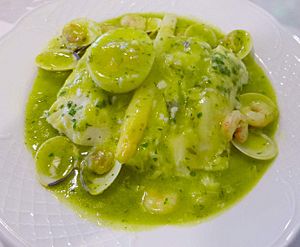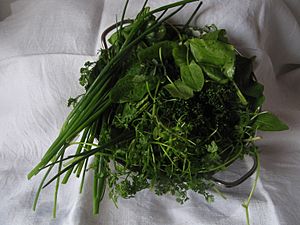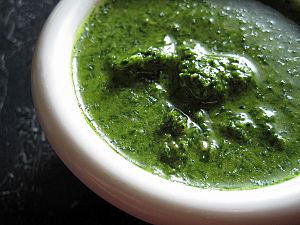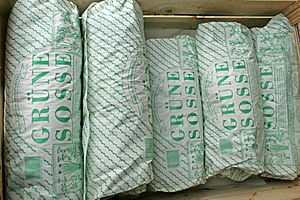Green sauce facts for kids
Green sauce is a group of cold, uncooked sauces. They are mostly made from chopped herbs. You can find different types of green sauce around the world. For example, there's the Spanish and Italian salsa verde, the French sauce verte, the German Grüne Soße, and the British mint sauce. Argentina has chimichurri, which is also a green sauce.
It's important to know that the Mexican salsa verde is a bit different. It's also called a "green sauce," but it's made from tomatillos. The version from New Mexico uses a special green chile as its base.
Contents
A Look Back: The History of Green Sauce
Green sauce has been around for a very long time in many parts of Europe. People were definitely using it in the Middle Ages. It might even be as old as the Roman Empire!
In the 14th century, a green sauce made with parsley and sage was very common. One old recipe suggested serving it to important people. It was thought to help them feel better and make them hungry.
The basic idea for green sauce probably came from the Near East. This means it could be at least 2,000 years old! Roman soldiers, called legionaries, brought it to Italy. From Italy, it spread to France and Germany. Some records suggest that Italian traders brought it to Frankfurt around the year 1700.
The German version might have come from French Protestant immigrants. They moved to Kurhessen in the 1700s. The German sauce uses different herbs because Mediterranean herbs were not easy to find in Germany back then.
Green Sauce in Ancient Rome
An ancient Roman cookbook called Apicius, from the 1st century CE, mentions a "Green sauce for fowl." This old recipe included ingredients like pepper, caraway, bay leaves, various green herbs, dates, honey, vinegar, wine, and oil.
Green Sauce Around the World
Spain: Salsa Verde with Fish
In Spain, salsa verde (which means "green sauce") is usually a sauce for fish. To make it, cooks start with a base of garlic and onion cooked gently, called a sofrito. Then, a piece of fish, often hake or clams, is added.
After the fish cooks a bit, white wine and fish broth are added. The fish then boils in this mix, and the sauce gets thicker. Finally, parsley is added. This gives the sauce its bright green color. A very popular dish is Merluza en salsa verde (Hake in green sauce). Sometimes, other green herbs like spinach or tarragon are used too.
Italy: Salsa Verde for Meats
The Italian salsa verde is a cold, country-style sauce. It's made with parsley, vinegar, capers, garlic, onion, anchovies, and olive oil. Sometimes, a little mustard is added. The ingredients are chopped, often using a food processor today.
In some parts of Italy, cubed bread is soaked in vinegar and mixed in. This makes the sauce a bit like a vinaigrette. In other areas, no bread is used.
Italian salsa verde is used as a dipping sauce or condiment for meats, fish, poultry, or vegetables. It's a classic sauce served with bollito misto (a mix of boiled meats) in regions like Piemonte and Lombardia. It's also served with grilled or stewed fish.
A green sauce with garlic, called agliata, is a special dish in the Siena region. Another green sauce in Italian cooking is Gremolata. It's from Milan and uses parsley, lemon peel, and garlic. It's often served with ossobuco, a famous meat dish.
France: Sauce Verte with Mayonnaise
The French sauce verte au pain (green sauce with bread) was known during the Renaissance. It was very similar to the Italian version. Today, French sauce verte is usually mayonnaise flavored with tarragon. Sometimes, parsley and sage are also added. Lemon juice is often used instead of vinegar.
Germany: Grüne Soße and Its Seven Herbs
Grüne Soße (Green Sauce) is a special dish from the German state of Hesse. It's very popular in cities like Frankfurt am Main (where it's called "Grie Soß") and Kassel.
The Frankfurt style uses exactly seven fresh herbs: parsley, chives, chervil, borage, sorrel, garden cress, and salad burnet. These herbs are mixed with sour cream, oil, vinegar, mustard, salt, and hard-boiled eggs. Other areas might use herbs like dill or spinach. In older, tougher times, people even used daisy leaves or dandelion leaves.
To make it, the hard-boiled eggs are mashed or pureed and mixed with sour cream to create a creamy base. Then, the fresh chopped herbs are added. Some recipes use buttermilk, quark, or yogurt instead of sour cream.
This sauce is served cold with boiled potatoes or rye bread. It often goes with hard-boiled eggs or roast beef. It can also be a side dish for barbecue. A local dish called Frankfurter Schnitzel is always served with green sauce. It's said that the famous writer Johann Wolfgang von Goethe loved green sauce.
The importance of this dish in Frankfurt is clear. You can find lots of green sauce at local markets. There's even a Green Sauce Monument in Frankfurt-Oberrad, built in 2007. It has seven small greenhouses, each growing one of the main herbs! Many families in Hesse eat Green Sauce on Maundy Thursday. This is because the German name for that day, Gründonnerstag, means "Green Thursday."
Britain: Greensauce with Sorrel
British greensauce is made from herbs, especially sorrel, mixed with vinegar and sugar. It's eaten with meat. The first mention of it was in the 12th century. An old recipe included sage, parsley, thyme, garlic, salt, and pepper. Sorrel was used so much that sometimes the herb itself was called 'greensauce'.
Argentina: Chimichurri
Chimichurri is a green sauce used in Argentina and other parts of Latin America. It's usually served with grilled meat, especially barbecue.
See also
 In Spanish: Salsa verde para niños
In Spanish: Salsa verde para niños






